Preventing Opioid Related Harm in Acute Pain
Opioid deaths in Ontario have continued to rise over the course of the pandemic1. Pharmacists can help save lives by ensuring the availability of naloxone kits and by providing opioid agonist therapy for people with opioid use disorder. However, we also have important stewardship responsibilities to prevent harms when opioids are used for acute pain. Most people have significant quantities of opioids leftover after an episode of acute pain and these can cause harm2. Dispensing larger quantities can also increase the risk of patients becoming long-term opioid users which is associated with the development of an opioid use disorder as well as endocrine problems, depression and motor vehicle accidents3,4,5.
Helping Minimise the Risks Associated with Opioid Use in Acute Pain
We have developed this complimentary module series to enable you to dispense appropriate doses and quantities of opioids for opioid naive patients with acute pain according to current best practice in Ontario and OCP Opioid Policy6,7,8. This will help you minimise the risks associated with opioids in acute pain for your patients. The modules and clinical resources section below also include tools such as patient handouts and posters to help you in your practice.
There are 5 modules - each is approximately 15 to 20 minutes long.
Please click on the tab below to access the modules. Thank you for taking the time to further your practice in this area! It all counts towards the safer use of opioids in our society.
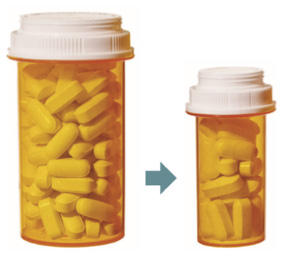
Funding provided by the Substance Use and Addictions Program, Health Canada. The views expressed herein do not necessarily represent the views of Health Canada.
See below to access a variety of opioid related resources that community pharmacists can use both in their discussions with patients and for their own education. For example, a patient handout and poster around safe quantities of opioids for acute pain are available in the 'Patient and Family' section and standards and guidelines of relevance are available in the 'Healthcare Provider' section. The tools presented in the modules are also included and can be downloaded below.
 Clinical Resource: Patient and Family
Clinical Resource: Patient and Family
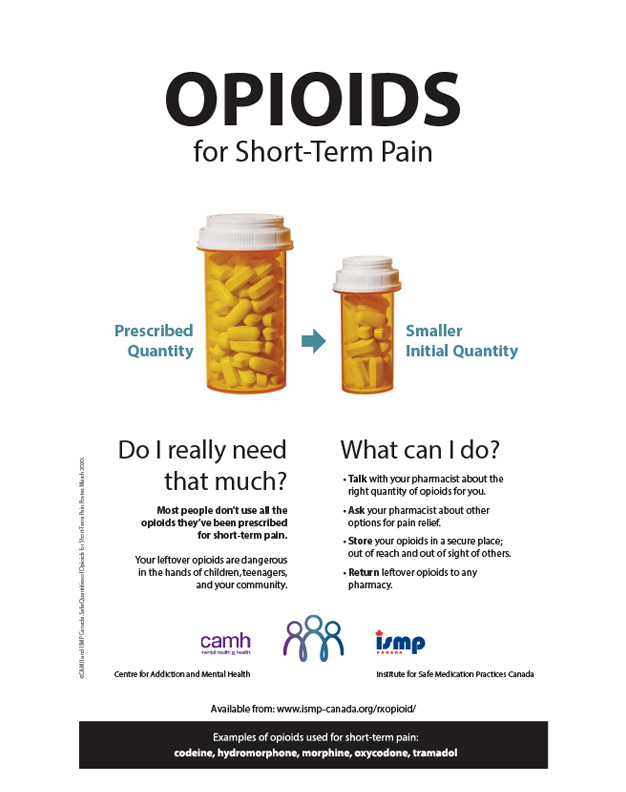
Safe Quantities of Opioids for Short-Term Pain Poster (11x17)
Pharmacists can display this poster in their pharmacy to alert patients to the fact that they may not need all the opioids they've been prescribed for acute pain.
Download: English
(CAMH and ISMP Canada)
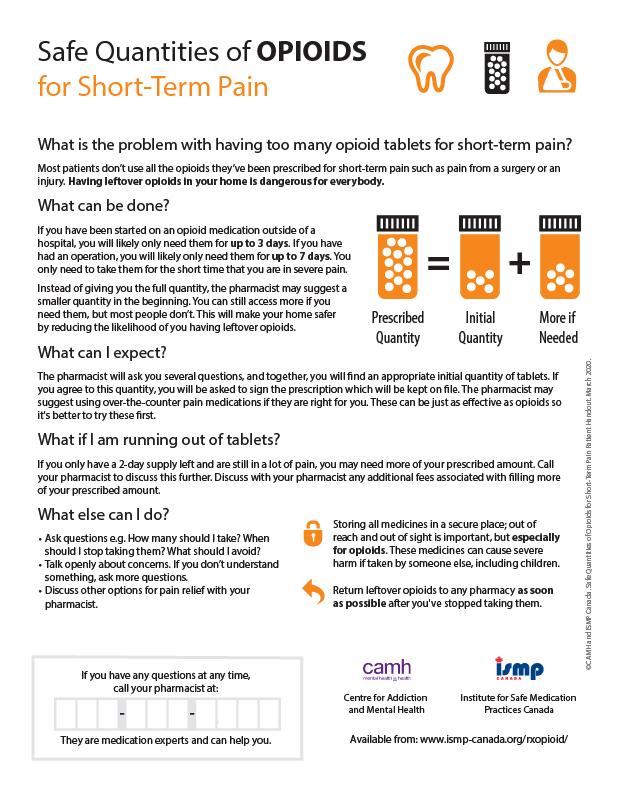
Safe Quantities of Opioids for Short-Term Pain Patient Handout Handout (8.5x11)
This patient handout outlines the rationale for appropriate quantities of opioids for acute pain. Pharmacists can use this to discuss smaller initial quantities of opioids with patients, and what to expect if they choose to have a lower quantity.
Download: English
(CAMH and ISMP Canada)
 Clinical Resource: Health Care Provider
Clinical Resource: Health Care Provider
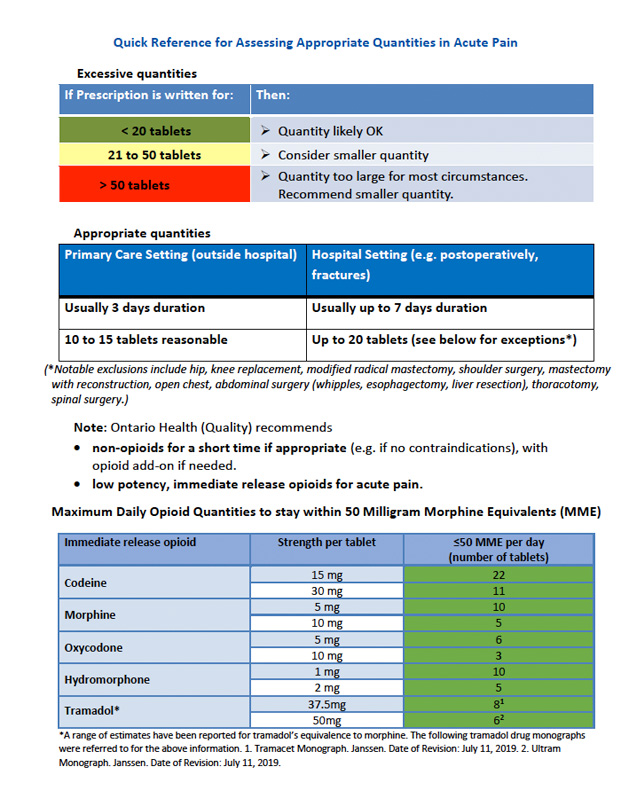
Quick Reference for Assessing Opioid Quantities for Acute Pain
This is a pragmatic approach to help pharmacists identify excessive quantities of opioids for acute pain and define an appropriate quantity.
Download:
English
(CAMH and ISMP Canada)
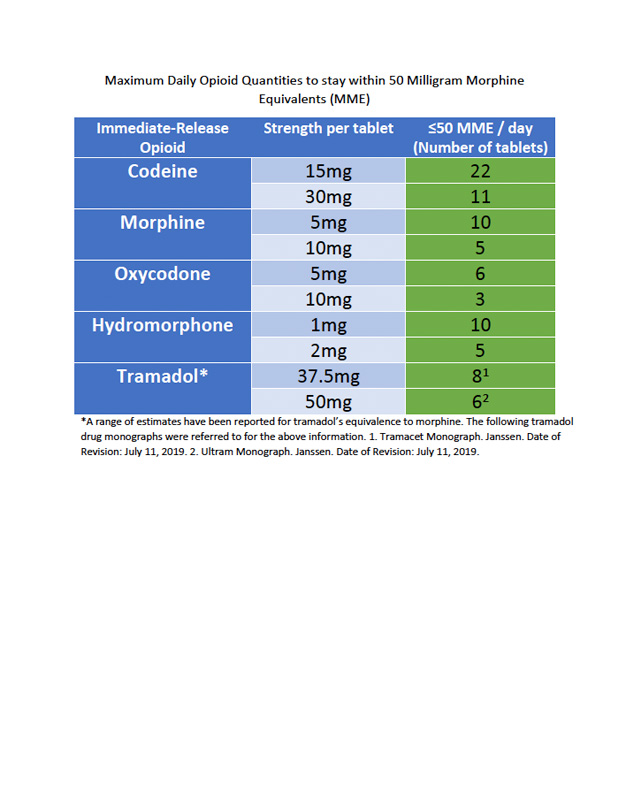
Maximum Daily Opioid Quantities to stay within 50 milligram morphine equivalents (MME) Table
Pharmacists can refer to this when they need to calculate the maximum number of tablets of commonly used opioid products that a patient can take in one day to stay within the recommended 50 MME per day for opioid naive patients.
Download:
English
(CAMH and ISMP Canada)
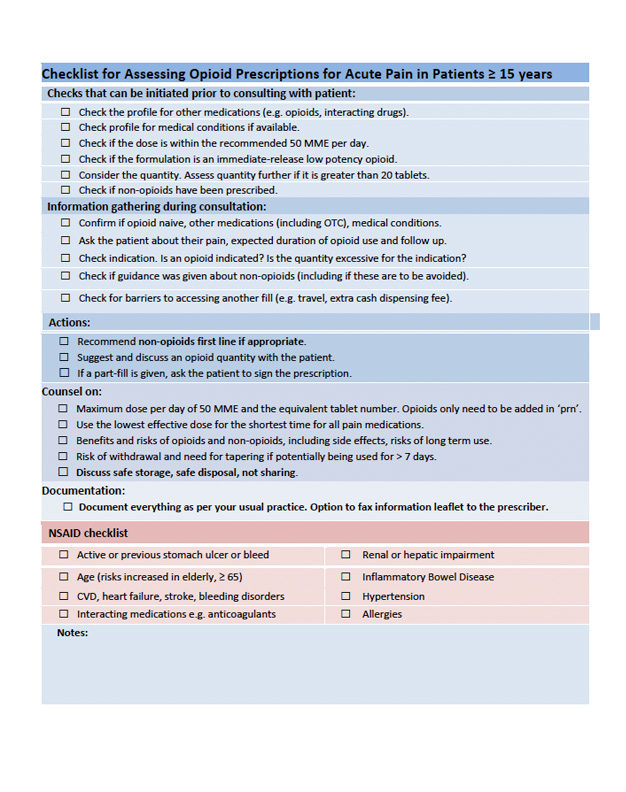
Checklist for Assessing Opioid Prescriptions for Acute Pain
This can help pharmacists systematically assess opioid prescriptions from the therapeutic check to patient counselling.
Download:
English
(CAMH and ISMP Canada)
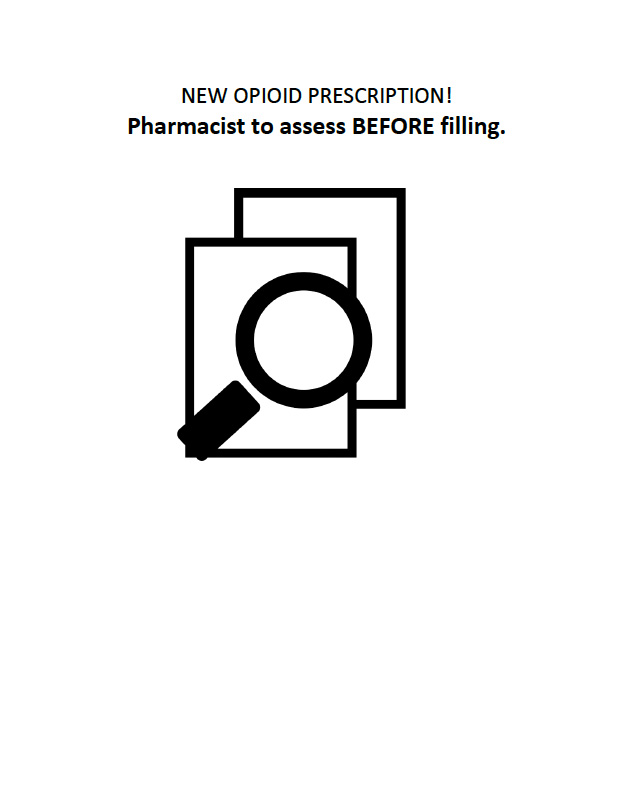
New Opioid Prescription! Pharmacist to assess BEFORE filling.
Download:
English
(CAMH and ISMP Canada)
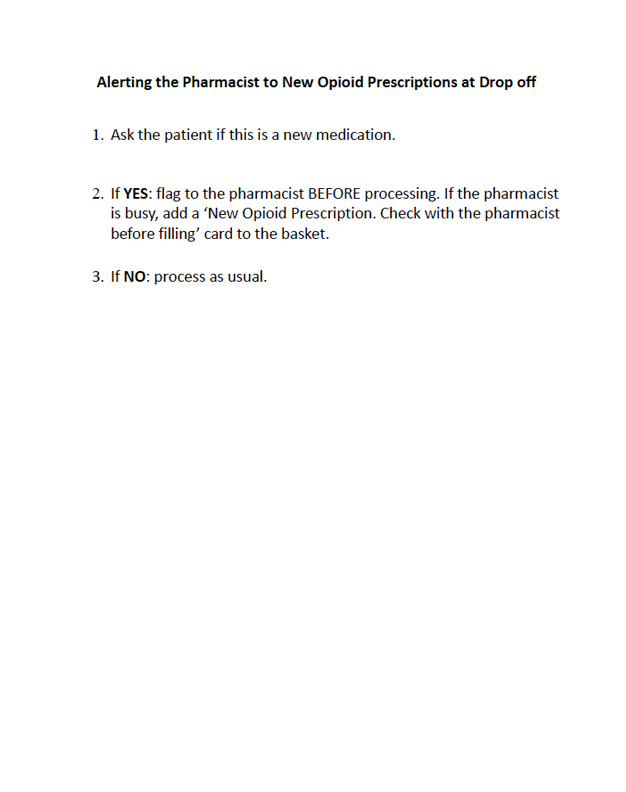
Alerting the Pharmacist to New Opioid Prescriptions at Drop Off.
Pharmacy staff can use this to identify new opioid prescriptions and flag them to the pharmacist for assessment.
Download:
English
(CAMH and ISMP Canada)
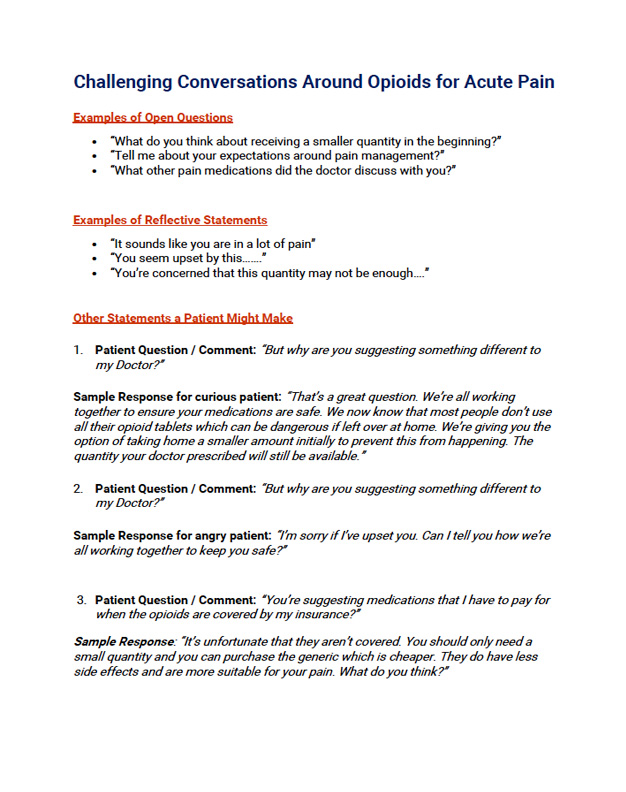
Challenging Conversations Around Opioids for Acute Pain
This describes concerns that patients may have when discussing opioids for acute pain. It also provides examples of pharmacist responses.
Download:
English
(CAMH and ISMP Canada)
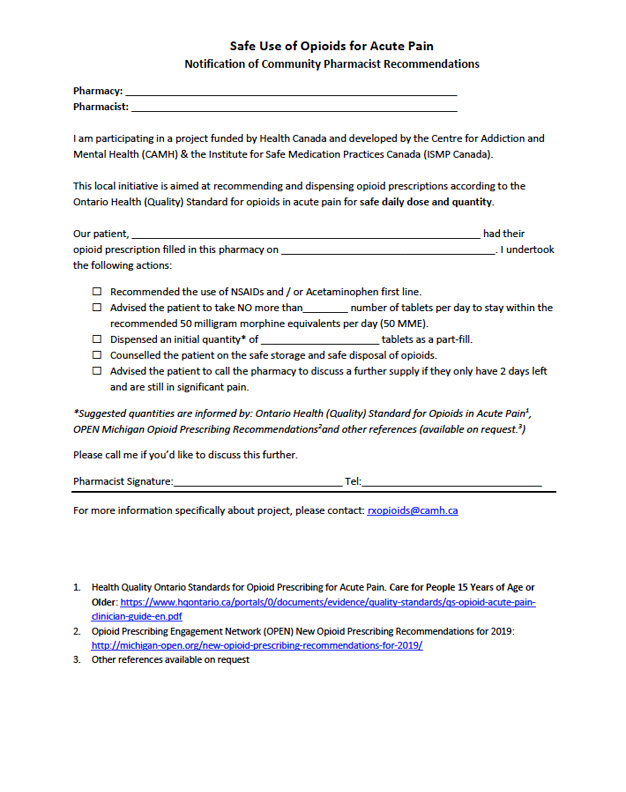
Fax template for Notifying Prescribers
This template allows the pharmacist to communicate any interventions they made on the opioid prescription to the prescriber. It also describes the rationale for dispensing appropriate quantities of opioids for acute pain.
Download:
English
(CAMH and ISMP Canada)
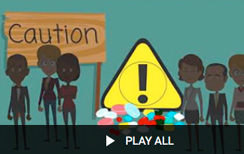
Question Opioids
Eight-part video series aimed at patients who have not started opioid medications.
(ISMP Canada)

Optimizing Patient Care Series: Motivating Patients to Promote Adherence
(Ontario College of Pharmacy)
1. https://www.publichealthontario.ca/-/media/documents/c/2021/changing-circumstances-infographic.pdf?sc_lang=en
2. Bicket M, Long J, Pronovost P et al. Prescription Opioid Analgesics Commonly Unused After Surgery. A Systematic Review. JAMA Surg. 2017;152(11):1066-1071.
3. Shah A, Hayes CJ, Martin BC. Characteristics of initial prescription episodes and likelihood of long-term opioid use - United States, 2006-2015. Morbidity Mortality Weekly Rep. 2017; 66(10):265-9: https://www.cdc.gov/mmwr/volumes/66/wr/mm6610a1.htm.
4. Else C, Jackson TD, Kunyk D et al. Adverse events associated with medium- and long-term use of opioids for chronic non-cancer pain: an overview of Cochrane Reviews (Review). Cochrane Library. 2017.
5. Neuman M, Bateman B, Wunsch H. Inappropriate opioid prescriptions after surgery. Lancet. 2019; 393:1547-57.
6. Health Quality Ontario. Quality Standards. Opioid Prescribing for Acute Pain. Care for People 15 Years of Age and Older. 2018a. https://www.hqontario.ca/Evidence‐to‐Improve‐Care/Quality‐Standards/View‐all‐Quality‐Standards/Opioid‐Prescribing‐for‐Acute‐Pain.
7. Best Practice in Surgery. University of Toronto. Guidelines: Prescription of Pain Medication at Discharge. March 2020. http://bestpracticeinsurgery.ca/guidelines/painmed/. Accessed September 14th 2021.
8. Ontario College of Pharmacists Opioid Policy. https://www.ocpinfo.com/regulations-standards/practice-policies-guidelines/opioid-policy/